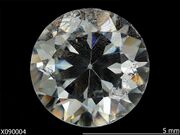Difference between revisions of "Strontium titanate"
m (Text replace - "\[http:\/\/cameo\.mfa\.org\/materials\/fullrecord\.asp\?name=([^\s]+)\s(.*)\]" to "$2") |
|||
| (3 intermediate revisions by the same user not shown) | |||
| Line 1: | Line 1: | ||
| + | [[File:Tausonite X090004 Sample Photo 24554 M.jpg|thumb|Synthetic strontium titanate gemstone; Gemological Institute of America]] | ||
== Description == | == Description == | ||
| − | Transparent, colorless single crystals of strontium titanate have been grown synthetically since the late 1940s. Strontium titanate is used | + | Transparent, colorless single crystals of strontium titanate have been grown synthetically since the late 1940s. Strontium titanate is used for [[imitation%20diamond|imitation diamonds]] and electronic components. The natural mineral of strontium titanate (tausonite) is muddy brown to gray color and was discovered in 1982. Synthetic strontium shows more fire than diamonds but is similarly isotropic, meaning there is no distracting doubling of facets as seen in synthetic rutile.. However, due to its softness, the facets and polish so not maintain well. The surface may also show residual polishing marks. Their density makes allows loose stones to be easily distinguished from diamonds. Synthetic strontium titanate is transparent and colorless, but may be doped to formed red, yellow,brown or blue. |
| − | + | [[File:Tausonite Raman RRUFF X090004.png|thumb|Raman spectrum of synthetic strontium titanate; [https://rruff.info/tausonite/display=default/ RRUFF]]] | |
== Synonyms and Related Terms == | == Synonyms and Related Terms == | ||
| − | imitation diamond | + | tausonite; imitation diamond; Brilliante; Diagem; Diamontina; Fabulite; Marvelite |
| − | == | + | == Physical and Chemical Properties == |
| − | Insoluble in water. Attacked by hydrofluoric acid. | + | * Insoluble in water. Attacked by hydrofluoric acid. |
| − | + | * Crystal system = cubic | |
| − | Crystal | + | * Fracture = conchoidal |
| + | * Cleavage = none | ||
| + | * Luster = adamantine | ||
| + | * Streak = brown | ||
| + | * Fluorescence = generally inert | ||
| + | * Dispersion = 0.190 (extreme fire) | ||
{| class="wikitable" | {| class="wikitable" | ||
| Line 22: | Line 28: | ||
|- | |- | ||
! scope="row"| Melting Point | ! scope="row"| Melting Point | ||
| − | | | + | | 2080 C |
|- | |- | ||
| − | ! scope="row"| Density | + | ! scope="row"| Density (g/ml) |
| 4.81-4.88 (nat.) 5.13 (syn.) | | 4.81-4.88 (nat.) 5.13 (syn.) | ||
|- | |- | ||
! scope="row"| Refractive Index | ! scope="row"| Refractive Index | ||
| − | | 2.41 | + | | 2.39 - 2.41 |
|} | |} | ||
| Line 35: | Line 41: | ||
[[media:download_file_472.pdf|Natural and Simulated Diamonds]] | [[media:download_file_472.pdf|Natural and Simulated Diamonds]] | ||
| − | + | ==Resources and Citations== | |
| − | + | * Gem Identification Lab Manual, Gemological Institute of America, 2016. | |
| − | == | ||
| − | |||
* Richard S. Lewis, ''Hawley's Condensed Chemical Dictionary'', Van Nostrand Reinhold, New York, 10th ed., 1993 | * Richard S. Lewis, ''Hawley's Condensed Chemical Dictionary'', Van Nostrand Reinhold, New York, 10th ed., 1993 | ||
| − | + | * Wikipedia: [https://en.wikipedia.org/wiki/Strontium_titanate Strontium_titanate] (Accessed Jan. 25, 2006 and Dec 2022) | |
| − | * Wikipedia | ||
[[Category:Materials database]] | [[Category:Materials database]] | ||
Latest revision as of 10:53, 4 January 2023
Description
Transparent, colorless single crystals of strontium titanate have been grown synthetically since the late 1940s. Strontium titanate is used for imitation diamonds and electronic components. The natural mineral of strontium titanate (tausonite) is muddy brown to gray color and was discovered in 1982. Synthetic strontium shows more fire than diamonds but is similarly isotropic, meaning there is no distracting doubling of facets as seen in synthetic rutile.. However, due to its softness, the facets and polish so not maintain well. The surface may also show residual polishing marks. Their density makes allows loose stones to be easily distinguished from diamonds. Synthetic strontium titanate is transparent and colorless, but may be doped to formed red, yellow,brown or blue.

Synonyms and Related Terms
tausonite; imitation diamond; Brilliante; Diagem; Diamontina; Fabulite; Marvelite
Physical and Chemical Properties
- Insoluble in water. Attacked by hydrofluoric acid.
- Crystal system = cubic
- Fracture = conchoidal
- Cleavage = none
- Luster = adamantine
- Streak = brown
- Fluorescence = generally inert
- Dispersion = 0.190 (extreme fire)
| Composition | SrTiO3 |
|---|---|
| Mohs Hardness | 6.0-6.5 (nat.) 5.5 (syn.) |
| Melting Point | 2080 C |
| Density (g/ml) | 4.81-4.88 (nat.) 5.13 (syn.) |
| Refractive Index | 2.39 - 2.41 |
Comparisons
Natural and Simulated Diamonds
Resources and Citations
- Gem Identification Lab Manual, Gemological Institute of America, 2016.
- Richard S. Lewis, Hawley's Condensed Chemical Dictionary, Van Nostrand Reinhold, New York, 10th ed., 1993
- Wikipedia: Strontium_titanate (Accessed Jan. 25, 2006 and Dec 2022)
